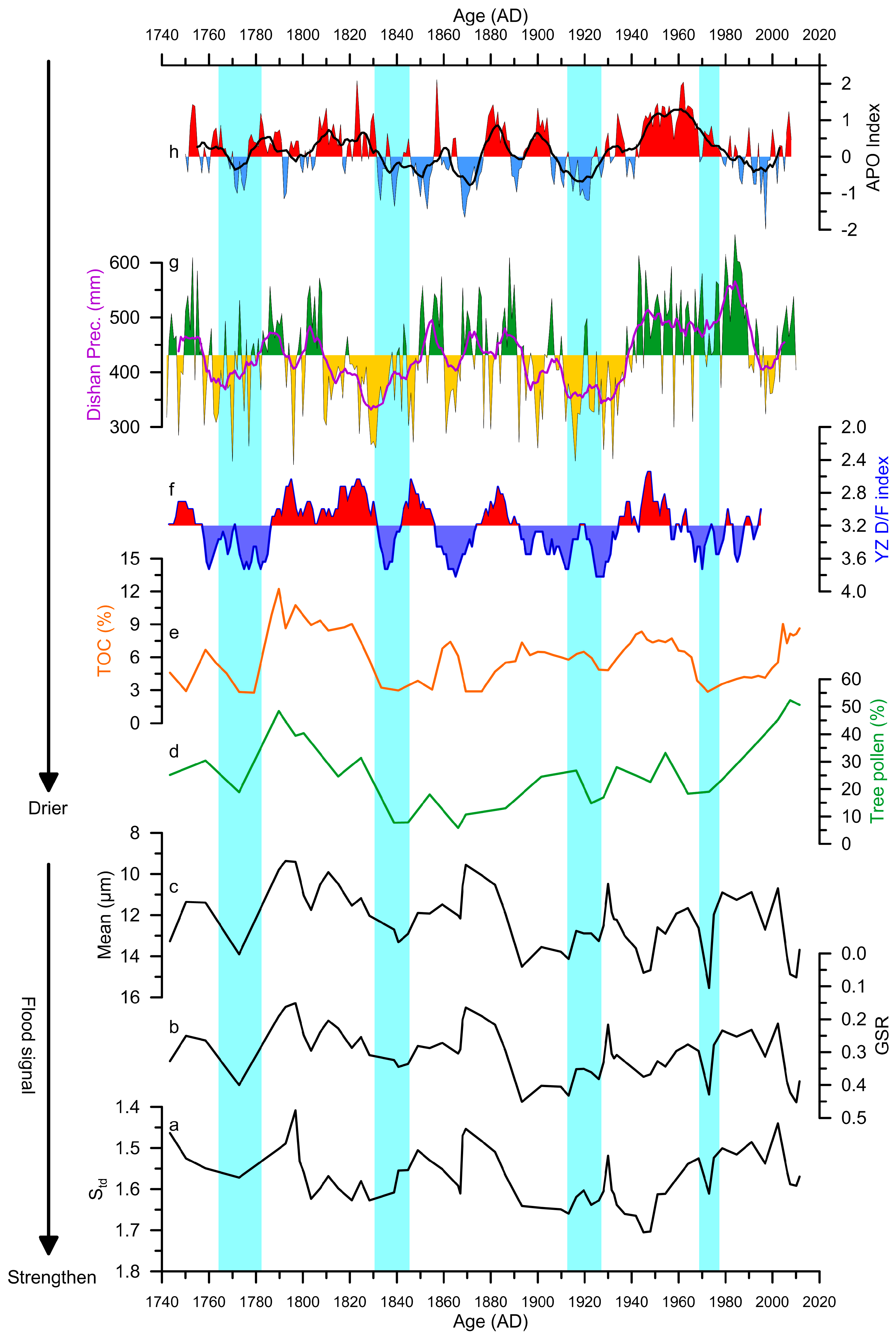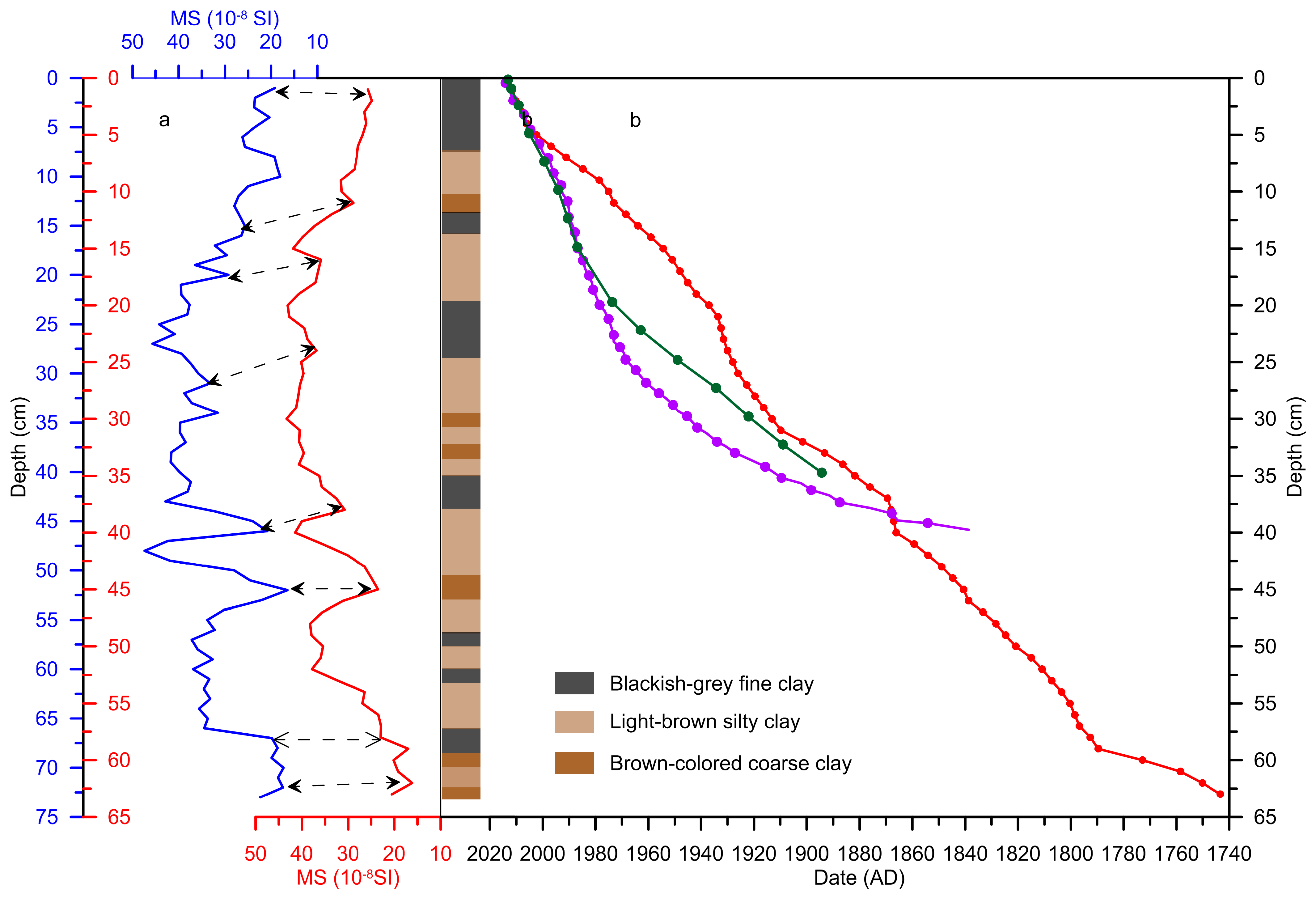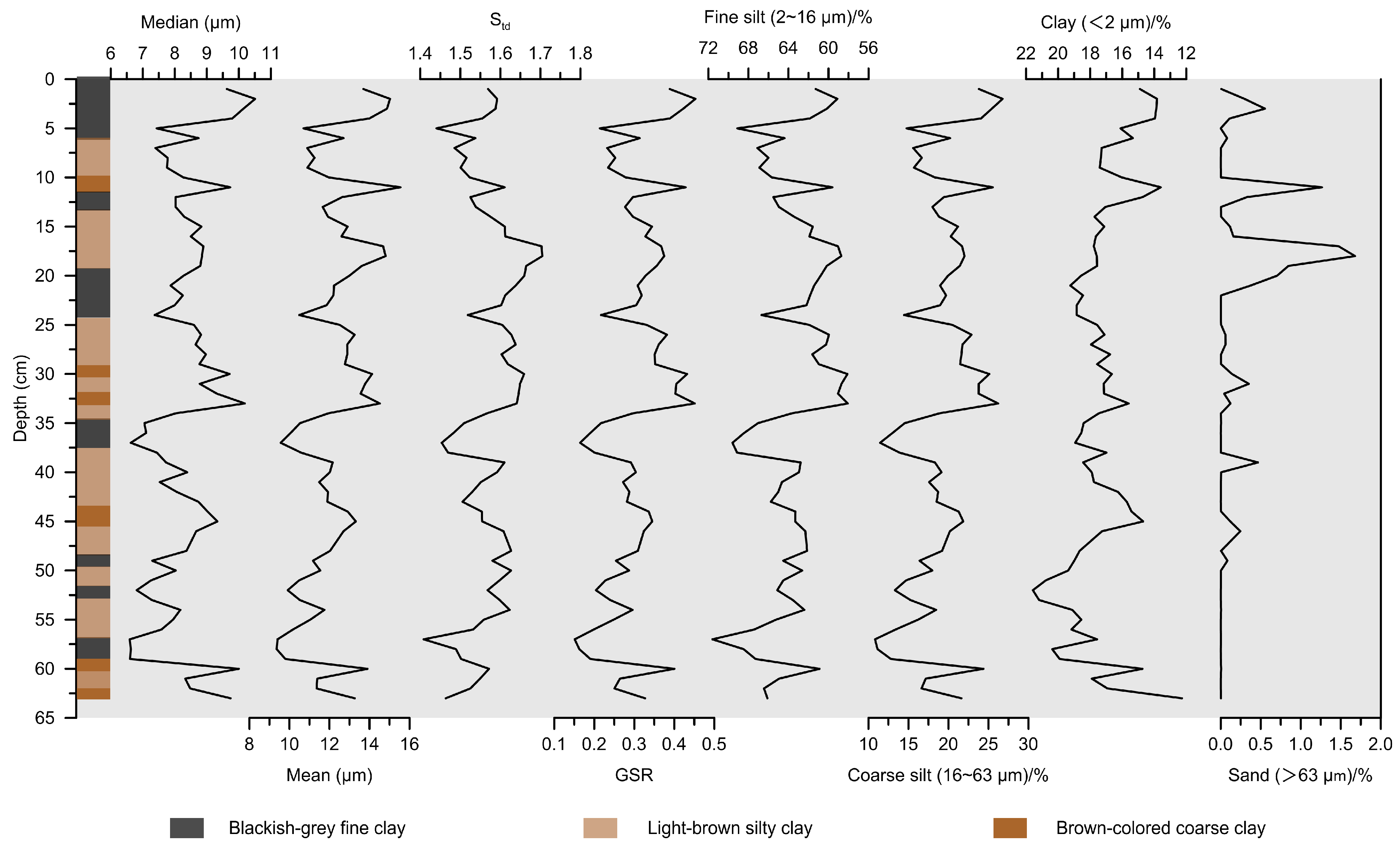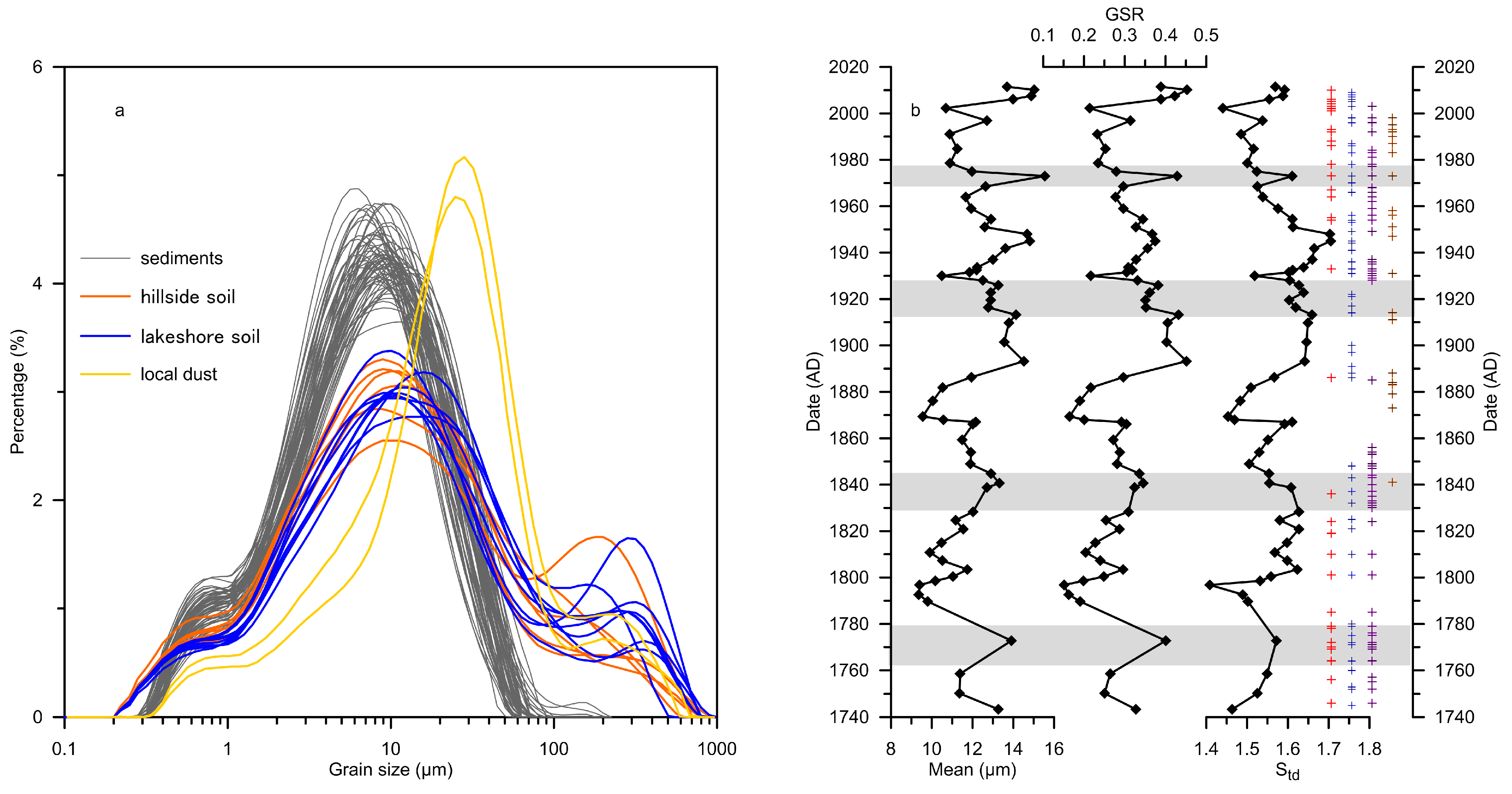Grain Size in an Alpine Lake from the Chinese Loess Plateau: Implications for Paleofloods and East Asian Summer Monsoon Variability
Abstract
1. Introduction
2. Setting of Lake Chaonaqiu
3. Materials and Methods
4. Results
4.1. Age Model
4.2. Grain Size
5. Discussion
5.1. Sensitivity of Grain-Size Distribution to Flood Input
5.2. Overlapping with Historic Floods
5.3. Flood Signal Variability Linked to the East Asian Summer Monsoon

6. Conclusions
Author Contributions
Funding
Data Availability Statement
Conflicts of Interest
References
- IPCC. Special Report on Global Warming of 1.5; Cambridge University Press: Cambridge, UK, 2018. [Google Scholar]
- IPCC. Climate Change 2021: The Physical Science Basis. In Contribution of Working Group I to the Sixth Assessment Report of the Intergovernmental Panel on Climate Change; Cambridge University Press: Cambridge, UK, 2023. [Google Scholar]
- Støren, N.; Dahl, S.; Nesje, A.; Paasche, Ø. Identifying the sedimentary imprint of high-frequency Holocene river floods in lake sediments: Development and application of a new method. Quat. Sci. Rev. 2010, 29, 3021–3033. [Google Scholar] [CrossRef]
- Wirth, S.; Gilli, A.; Simonneau, A.; Ariztegui, D.; Vannière, B.; Glur, L.; Chapron, E.; Magny, M.; Anselmetti, F. A 2000 year long seasonal record of floods in the southern European Alps. Geophys. Res. Lett. 2013, 40, 4025–4029. [Google Scholar] [CrossRef]
- Wirth, S.; Glur, L.; Gilli, A.; Anselmetti, F. Holocene flood frequency across the Central Alps: Solar forcing and evidence for variations in North Atlantic atmospheric circulation. Quat. Sci. Rev. 2013, 80, 112–128. [Google Scholar] [CrossRef]
- Schlolaut, G.; Brauer, A.; Marshall, M.; Nakagawa, T.; Staff, R.; Ramsey, C.; Lamb, H.; Bryant, C.; Naumann, R.; Dulski, P.; et al. Event layers in the Japanese Lake Suigetsu ‘SG06’ sediment core: Description, interpretation and climatic implications. Quat. Sci. Rev. 2014, 83, 157–170. [Google Scholar] [CrossRef]
- Wang, X.; Jin, Z.; He, Z.; Zhou, L.; Xu, J. New insights into dating the sediment sequence within a landslide-dammed reservoir on the Chinese Loess Plateau. Holocene 2019, 29, 1020–1029. [Google Scholar] [CrossRef]
- Czymzik, M.; Brauer, A.; Dulski, P.; Plessen, B.; Naumann, R.; Grafenstein, U.; Scheffler, R. Orbital and solar forcing of shifts in mid- to late Holocene flood intensity from varved sediments of pre-alpine Lake Ammersee (southern Germany). Quat. Sci. Rev. 2013, 61, 96–110. [Google Scholar] [CrossRef]
- Glur, L.; Wirth, S.; Büntgen, U.; Gilli, A.; Haug, G.; Schär, C.; Beer, J.; Anselmetti, F. Frequent floods in the European Alps coincide with cooler periods of the past 2500 years. Sci. Rep. 2013, 3, 2770. [Google Scholar] [CrossRef]
- Suzuki, Y.; Tada, R.; Nagashima, K.; Nakagawa, T.; Gotanda, K.; Haraguchi, T.; Schlolaut, G. Extreme flood events and their frequency variations during the middle to late Holocene recorded in the sediment of Lake Suigetsu, central Japan. Holocene 2021, 31, 121–133. [Google Scholar] [CrossRef]
- Shao, S.; Wu, D.; Wang, T.; Guo, S.; Xiao, Q.; Li, Y.; Feng, X.; Deng, H.; Tang, Q.; Chen, F. Holocene extreme flood events in the middle reaches of the Lancang–Mekong River basin recorded by a high-altitude lake in southwestern China. Quat. Sci. Rev. 2024, 343, 108918. [Google Scholar] [CrossRef]
- Ding, Z.; Yu, Z.; Yang, S.; Sun, J.; Xiong, S.; Liu, T. Coeval changes in grain size and sedimentation rate of eolian loess, the Chinese Loess Plateau. Geophys. Res. Lett. 2001, 28, 2097–2100. [Google Scholar] [CrossRef]
- Sun, J. Provenance, forming mechanism and transport of loess in China. Quat. Sci. 2004, 24, 175–183, (In Chinese with English Abstract). [Google Scholar]
- An, Z.; Zhang, P.; Wang, E.; Wang, S.; Qiang, X.; Li, L.; Song, Y.; Chang, H.; Liu, X.; Zhou, W.; et al. Changes of the monsoon-arid environment in China and growth of the Tibetan Plateau since the Miocene. Quat. Sci. 2006, 26, 678–693, (In Chinese with English Abstract). [Google Scholar]
- Sun, D.; Lu, H. Grain-size and dust accumulation rate of Late Cenozoic aeolian deposits and the inferred atmospheric circulation evolutions. Quat. Sci. 2007, 27, 251–262, (In Chinese with English Abstract). [Google Scholar]
- Sun, Y.; Kutzbach, J.; An, Z.; Clemens, S.; Liu, Z.; Liu, W.; Liu, X.; Shi, Z.; Zheng, W.; Liang, L.; et al. Astronomical and glacial forcing of East Asian summer monsoon variability. Quat. Sci. Rev. 2015, 115, 132–142. [Google Scholar] [CrossRef]
- Sun, Y.; Gao, S.; Li, J. Preliminary analysis of grain-size populations with environmentally sensitive terrigenous components in marginal sea setting. Chin. Sci. Bull. 2003, 48, 184–187. [Google Scholar] [CrossRef]
- Zheng, H.; Chen, G.; Xie, X.; Mei, X.; Li, J.; Ge, H.; Huang, E. Grain size distribution and dynamic control of Late Quaternary terrigenous sediments in the South China sea and their implication for East Asian monsoon evolution. Quat. Sci. 2008, 28, 414–424, (In Chinese with English Abstract). [Google Scholar]
- Zhou, X.; Yang, W.; Xiang, R.; Wang, Y.; Sun, L. Re-examining the potential of using sensitive grain size of coastal muddy sediments as proxy of winter monsoon strength. Quat. Int. 2014, 333, 173–178. [Google Scholar] [CrossRef]
- Liu, X.; Wang, S.; Shen, J. The grain size of the core QH-2000 in Qinghai Lake and its implication for paleoclimate and paleoenvironment. J. Lake Sci. 2003, 15, 112–117, (In Chinese with English Abstract). [Google Scholar]
- Zhang, J.; Jin, M.; Chen, F.; Battarbee, R.; Henderson, A. Precipitation variations in the Northeast Tibetan Plateau over the last 800 years documented by sediment cores of Qinghai Lake. Chin. Sci. Bull. 2004, 49, 10–14, (In Chinese with English Abstract). [Google Scholar] [CrossRef]
- Chen, J.; Wan, G.; Zhang, D.; Zhang, F.; Huang, R. Environmental records of lacustrine sediments in different time scales: Sediment grain size as an example. Sci. China Ser. D Earth Sci. 2004, 47, 954–960. [Google Scholar] [CrossRef]
- Han, Y.; Xiao, X.; Yang, X.; Zhang, E.; Xiao, J. The grain-size characteristics of Tiancai Lake in northwestern of Yunnan Province and paleo-precipitation history during the Holocene. Quat. Sci. 2011, 31, 999–1010, (In Chinese with English Abstract). [Google Scholar]
- Sheng, E.; Yu, K.; Xu, H.; Lan, J.; Liu, B.; Che, S. Late Holocene Indian summer monsoon precipitation history at Lake Lugu, northwestern Yunnan Province, Southwestern China. Palaeogeogr. Palaeoclimatol. Palaeoecol. 2015, 438, 24–33. [Google Scholar] [CrossRef]
- Liu, X.; Vandenberghe, J.; An, Z.; Li, Y.; Jin, Z.; Dong, J.; Sun, Y. Grain size of Lake Qinghai sediments: Implications for riverine input and Holocene monsoon variability. Palaeogeogr. Palaeoclimatol. Palaeoecol. 2016, 449, 41–51. [Google Scholar] [CrossRef]
- Tan, J.; Xiao, X.; Li, Y. Late Holocene climatic change revealed by sediment records in Gegongcuonaka Lake, northwestern Yunnan Province. Quat. Sci. 2018, 38, 900–911, (In Chinese with English Abstract). [Google Scholar]
- He, W.; Wang, G.; Wang, Y.; Wei, Z.; Gong, J.; Zhang, T.; Ma, X.; Yu, X. Characteristics of climate and environment over the past 30 cal.ka B.P. recorded in lacustrine deposits of the Qionghai Lake, Sichuan Province. Quat. Sci. 2018, 38, 1179–1192, (In Chinese with English Abstract). [Google Scholar]
- Lan, J.; Xu, H.; Yu, K.; Sheng, E.; Zhou, K.; Wang, T.; Ye, Y.; Yan, D.; Wu, H.; Cheng, P.; et al. Late Holocene hydroclimatic variations and possible forcing mechanisms over the eastern Central Asia. Sci. China Earth Sci. 2019, 62, 1288–1301. [Google Scholar] [CrossRef]
- Sun, Q.; Zhou, J.; Xiao, J. Grain-size characteristics of Lake Daihai sediments and its paleoenvironment significance. Mari. Geol. Quat. Geol. 2001, 21, 93–95, (In Chinese with English Abstract). [Google Scholar]
- Liu, X.; Herzschuh, U.; Shen, J.; Jiang, Q.; Xiao, X. Holocene environmental and climatic changes inferred from Wulungu Lake in northern Xinjiang, China. Quat. Res. 2008, 70, 412–425. [Google Scholar] [CrossRef]
- Xiao, J.; Chang, Z.; Si, B.; Qin, X.; Itoh, S.; Lomtatidze, Z. Partitioning of the grain-size components of Dali Lake core sediments: Evidence for lake-level changes during the Holocene. J. Paleolimnol. 2009, 42, 249–260. [Google Scholar] [CrossRef]
- Xiao, J.; Fan, J.; Zhou, L.; Zhai, D.; Wen, R.; Qin, X. A model for linking grain-size component to lake level status of a modern clastic lake. J. Asian Earth Sci. 2013, 355, 34–43. [Google Scholar] [CrossRef]
- Guo, C.; Ma, Y.; Liu, J.; Li, D.; Hu, C.; Pei, Q.; Wu, Y. Climatic change recorded by grain size in the past about 2000 years from Yanzhog Yumco Lake, Tibet. Quat. Sci. 2016, 36, 405–419, (In Chinese with English Abstract). [Google Scholar]
- Ye, Y.; Xu, H.; Lan, J.; Yan, D.; Zhou, K.; Wu, H.; Zhang, J.; Sheng, E.; Yu, K.; Liu, B. Sedimentary grain size at Lake Chenghai, Yunnan Province: Indicator for water depth. Quat. Sci. 2018, 38, 1007–1016, (In Chinese with English Abstract). [Google Scholar]
- Li, Y.; Guo, Y.; Yu, G. An analysis of extreme flood events during the past 400 years at Taihu Lake, China. J. Hydrol. 2013, 500, 217–225. [Google Scholar] [CrossRef]
- Chen, F.; Xu, Q.; Chen, J.; Birks, H.; Liu, J.; Zhang, S.; Jin, L.; An, C.; Telford, R.; Cao, X.; et al. East Asian summer monsoon precipitation variability since the last deglaciation. Sci. Rep. 2015, 5, 11186. [Google Scholar] [CrossRef] [PubMed]
- Kimura, R.; Takayama, N. Restoration and Development of the Degraded Loess Plateau, China. In Climate of the Loess Plateau; Tsunekawa, A., Liu, G., Yamanaka, N., Du, S., Eds.; Ecological Research Monographs; Springer: Tokyo, Japan, 2014; pp. 23–33. [Google Scholar] [CrossRef]
- Zhang, X.; Wen, Z.; Feng, M.; Yang, Q.; Zheng, J. Application of 137Cs fingerprinting technique to interpreting sediment production records from reservoir deposits in a small catchment of the Hilly Loess Plateau, China. Sci. China Ser. D Earth Sci. 2007, 37, 405–410. [Google Scholar] [CrossRef]
- Long, Y.; Zhang, X.; Li, M.; Li, M.; Zhang, Y. Identification of the deposited layers in landslides reservoir and investigation of the sediment yields during the later sixteenth century on the Hill Loess Plateau, China. Chin. Sci. Bull. 2008, 53, 3908–3913. [Google Scholar] [CrossRef]
- Zhang, X.; Walling, D.; He, X.; Long, Y. Use of landslide-dammed lake deposits and pollen tracing techniques to investigate the erosional response of a small drainage basin in the Loess Plateau, China, to land use change during the late 16th century. Catena 2009, 79, 205–213. [Google Scholar] [CrossRef]
- Wang, X.; Liu, F.; Zhang, X.; Tang, X.; Xu, J.; Huang, P.; Wang, Y.; Jin, Z. Asynchronized erosion effects due to climate and human activities on the central Chinese Loess Plateau during the Anthropocene and its implications for future soil and water management. Earth Surf. Proc. Landf. 2022, 47, 1238–1251. [Google Scholar] [CrossRef]
- Wang, X.; Wang, Z.; Xiao, J.; He, M.; Zhang, F.; Pan, Y.; Zhang, Y.; Jin, Z. Soil erosion fluxes on the central Chinese Loess Plateau during CE 1811 to 1996 and the roles of monsoon storms and human activities. Catena 2021, 200, 105148. [Google Scholar] [CrossRef]
- Yu, K.; Xu, H.; Lan, J.; Sheng, E.; Liu, B.; Wu, H.; Tan, L.; Yeager, K. Climate change and soil erosion in a small alpine lake basin on the Loess Plateau, China. Earth Surf. Proc. Landf. 2017, 42, 1238–1247. [Google Scholar] [CrossRef]
- Chen, J.; Liu, J.; Xie, C.; Chen, G.; Chen, J.; Zhang, Z.; Zhou, A.; Rühland, K.; Smol, J.; Chen, F. Biogeochemical responses to climate change and anthropogenic nitrogen deposition from a ∼200-year record from Tianchi Lake, Chinese Loess Plateau. Quat. Int. 2018, 493, 22–30. [Google Scholar] [CrossRef]
- Guo, C.; Ma, Y.; Meng, H. Late Holocene vegetation, climate, and lake changes in northern China: Varved evidence from western Loess Plateau. Sci. Total Environ. 2022, 827, 154282. [Google Scholar] [CrossRef] [PubMed]
- Cheng, J.; Yu, Z.; Zhu, R.; Jin, J.; Jing, Z. Comprehensive Scientific Investigation Report of Liupan Mountains National Nature Reserve; Science Press: Beijing, China, 2013; pp. 6–84. (In Chinese) [Google Scholar]
- Yu, K.; Wang, L.; Sheng, E.; Liu, B.; Liu, X.; Lan, J. Environmental implication of magnetic susceptibility of lacustrine sediments in Lake Chaonaqiu, Liupan Mountain. Chin. J. Ecol. 2020, 39, 2501–2508, (In Chinese with English Abstract). [Google Scholar]
- Lu, H.; An, Z. Paleoclimatic significance of grain size of loess-palaeosol deposit in Chinese Loess Plateau. Sci. China Ser. D 1998, 41, 626–631. (In Chinese) [Google Scholar] [CrossRef]
- Li, X.; Shang, X.; Zhou, X.; Zhang, H. Integrative method of sieving and heavy liquid in pollen analysis of loess-data analysis and processing. Arid Land Geogr. 2006, 29, 663–667, (In Chinese with English Abstract). [Google Scholar]
- Zhou, X.; Li, X.; Dodson, J.; Yang, S.; Long, H.; Zhao, K.; Sun, N.; Yang, Q.; Liu, H.; Zhao, C. Zonal vegetation change in the Chinese Loess Plateau since MIS 3. Palaeogeogr. Palaeoclimatol. Palaeoecol. 2014, 404, 89–96. [Google Scholar] [CrossRef]
- Ma, J.; Zhou, X.; Yang, S.; Rao, H.; Li, J.; Hu, S.; Yang, Y.; Li, X. Middle Holocene hunting-gathering culture and environmental background of the steppe area of northern China. Sci. China Earth Sci. 2022, 65, 1317–1327. [Google Scholar] [CrossRef]
- Sun, H.; James, B.; Osamu, S.; Zhou, A. Mid- to- late Holocene hydroclimatic changes on the Chinese Loess Plateau: Evidence from n-alkanes from the sediments of Tianchi Lake. J. Paleolimnol. 2018, 60, 511–523. [Google Scholar] [CrossRef]
- Zhang, C.; Zhou, A.; Zhang, H.; Zhang, Q.; Zhang, X.; Sun, H.; Zhao, C. Soil erosion in relation to climate change and vegetation cover over the past 2000 years as inferred from the Tianchi lake in the Chinese Loess Plateau. J. Asian Earth Sci. 2019, 180, 103850. [Google Scholar] [CrossRef]
- Shen, J.; Xue, B.; Wu, J.; Wu, Y.; Liu, X.; Yang, X.; Liu, J.; Wang, S. Lake Sedimentation and Environmental Evolution; Science Press: Beijing, China, 2010; pp. 65–155. (In Chinese) [Google Scholar]
- Vandenberghe, J.; An, Z.; Nugteren, G.; Lu, H.; Van Huissteden, K. New absolute time scale for the quaternary climate in the Chinese loess region by grain-size analysis. Geology 1997, 25, 35–38. [Google Scholar] [CrossRef]
- Liu, L.; Yu, K.; Li, A.; Zhang, C.; Wang, L.; Liu, X.; Lan, J. Weathering Intensity Response to Climate Change on Decadal Scales: A Record of Rb/Sr Ratios from Chaonaqiu Lake Sediments, Western Chinese Loess Plateau. Water 2023, 15, 1890. [Google Scholar] [CrossRef]
- Yuan, L. Disasters History of Northwest; Gansu People Press: Lanzhou, China, 1994; pp. 701–950. (In Chinese) [Google Scholar]
- Wen, K.G. Chinese Meteorological Disasters Ceremony: Gansu Volume; Dong, A.X., Ed.; Meteorology Press: Beijing, China, 2005; pp. 189–234. (In Chinese) [Google Scholar]
- Wen, K.G. Chinese Meteorological Disasters Ceremony: Ningxia Volume; Xia, P.M., Ed.; Meteorology Press: Beijing, China, 2007; pp. 76–128. (In Chinese) [Google Scholar]
- OR (Official Revision). Veritable Records of Qing Dynasty; Zhong Hua Book Company: Beijing, China, 1986; Volume 9–59. (In Chinese) [Google Scholar]
- ZCCCC (Zhuanglang County Chronicles Compilation Committee). Zhuanglang County Chronicles; Zhong Hua Book Company: Beijing, China, 1997; pp. 79–80. (In Chinese) [Google Scholar]
- ZCCCC (Zhuanglang County Chronicles Compilation Committee). Zhuanglang County Chronicles (1991–2010); Local Chronicles Press: Beijing, China, 2019; p. 43. (In Chinese) [Google Scholar]
- HCCCC (Huating County Chronicles Compilation Committee). Huating County Chronicles; Gansu People’s Publishing House: Lanzhou, China, 1993; pp. 101–103. (In Chinese) [Google Scholar]
- HLCCC (Huating Local Chronicles Compilation Committee). Huating County Chronicles (1988–2009); Local Chronicles Press: Beijing, China, 2018; pp. 40–41. (In Chinese) [Google Scholar]
- LCCCC (Longde County Chronicles Compilation Committee). Longde County Chronicles; Ningxia People’s Publishing House: Yinchuan, China, 1998; pp. 50–56. (In Chinese) [Google Scholar]
- LLCCC (Longde Local Chronicles Compilation Committee). Longde County Chronicles (1991–2000); Local Chronicles: Beijing, China, 2005; pp. 9–21. (In Chinese) [Google Scholar]
- JCCCC (Jingyuan County Chronicles Compilation Committee). Jingyuan County Chronicles; Ningxia People’s Publishing House: Yinchuan, China, 1995; pp. 13–34. (In Chinese) [Google Scholar]
- JLCCC (Longde Local Chronicles Compilation Committee). Jingyuan County Chronicles (1991–2000); Local Chronicles: Beijing, China, 2003; pp. 1–24. (In Chinese) [Google Scholar]
- Fang, K.; Frank, D.; Gou, X.; Liu, C.; Zhou, F.; Li, J.; Li, Y. Precipitation over the past four centuries in the Dieshan Mountains as inferred from tree rings: An introduction to an HHT-based method. Glob. Planet. Chang. 2013, 107, 109–118. [Google Scholar] [CrossRef]
- CAMS (Chinese Academy of Meteorological Science). Yearly Charts of Dryness/Wetness in China for the Last 500-Year Period; Cartographic Publishing House: Beijing, China, 1981. (In Chinese) [Google Scholar]
- Zhang, D.; Li, X.; Liang, Y. Continued complement (1993–2000) of yearly charts of dryness/wetness in China for the last 500-year period. J. Appl. Meteorol. Sci. 2003, 14, 379–384. (In Chinese) [Google Scholar] [CrossRef]
- Zhang, D.; Liu, C. Continued complement (1980–1992) of yearly charts of dryness/wetness in China for the last 500-year period. Meteorol. Mon. 1993, 19, 41–45. (In Chinese) [Google Scholar]
- Yan, X.; Liu, J.; Rühland, K.; Smol, J.; Chen, F. Climate change as the dominant driver of recent ecological changes in a semi-arid alpine lake from the Chinese Loess Plateau. J. Paleolimnol. 2022, 68, 39–57. [Google Scholar] [CrossRef]
- Zhou, X.; Zhao, P.; Liu, G. Asian-Pacific Oscillation index and variation of East Asian summer monsoon over the past millennium. Chin. Sci. Bull. 2009, 54, 3768–3771. [Google Scholar] [CrossRef]
- Tan, M.; Liu, T.; Hou, J.; Qin, X.; Zhang, H.; Li, T. Cyclic rapid warming on centennial-scale revealed by a 2650-year stalagmite record of warm season temperature. Geophys. Res. Lett. 2003, 30, 1617–1620. [Google Scholar] [CrossRef]
- MacDonald, G.; Case, R.A. Variations in the Pacific decadal oscillation over the past millennium. Geophys. Res. Lett. 2005, 32, L08703. [Google Scholar] [CrossRef]
- Zhao, P.; Zhu, Y.; Zhang, R. An Asian-Pacific teleconnection in summer tropospheric temperature and associated Asian climate variability. Clim. Dyn. 2007, 29, 293–303. [Google Scholar] [CrossRef]




| No. | Year (AD) | Counties | No. | Year (AD) | Counties | No. | Year (AD) | Counties |
|---|---|---|---|---|---|---|---|---|
| 1 | 1745 | HT | 38 | 1848 | HT, LD | 75 | 1955 | ZL |
| 2 | 1746 | ZL, LD | 39 | 1849 | LD | 76 | 1956 | HT, LD, JY |
| 3 | 1752 | HT, LD | 40 | 1853 | LD | 77 | 1958 | JY |
| 4 | 1753 | HT | 41 | 1854 | LD | 78 | 1959 | LD |
| 5 | 1755 | LD | 42 | 1856 | LD | 79 | 1962 | LD |
| 6 | 1756 | ZL | 43 | 1873 | JY | 80 | 1964 | ZL, LD |
| 7 | 1757 | LD | 44 | 1879 | JY | 81 | 1966 | HT, LD |
| 8 | 1760 | HT | 45 | 1883 | JY | 82 | 1967 | ZL |
| 9 | 1764 | ZL, HT, LD | 46 | 1884 | JY | 83 | 1968 | LD |
| 10 | 1769 | ZL, LD | 47 | 1885 | LD | 84 | 1970 | HT |
| 11 | 1770 | ZL, LD | 48 | 1886 | ZL, HT | 85 | 1973 | ZL, HT, LD, JY |
| 12 | 1771 | HT, LD | 49 | 1888 | HT, JY | 86 | 1977 | LD |
| 13 | 1772 | ZL, HT, LD | 50 | 1891 | HT | 87 | 1978 | ZL, HT, LD |
| 14 | 1775 | HT, LD | 51 | 1897 | HT | 88 | 1981 | LD |
| 15 | 1776 | LD | 52 | 1900 | HT | 89 | 1983 | HT, LD, JY |
| 16 | 1778 | ZL | 53 | 1911 | JY | 90 | 1984 | LD |
| 17 | 1779 | ZL, HT, LD | 54 | 1914 | HT, JY | 91 | 1986 | HT |
| 18 | 1780 | HT, LD | 55 | 1917 | HT | 92 | 1987 | HT, JY |
| 19 | 1785 | ZL, LD | 56 | 1921 | HT | 93 | 1988 | ZL |
| 20 | 1801 | ZL, HT, LD | 57 | 1922 | HT | 94 | 1990 | JY |
| 21 | 1810 | ZL, HT, LD | 58 | 1928 | LD | 95 | 1992 | ZL, JY |
| 22 | 1819 | ZL | 59 | 1929 | LD | 96 | 1993 | ZL, JY |
| 23 | 1821 | HT | 60 | 1930 | LD | 97 | 1995 | JY |
| 24 | 1824 | ZL, LD | 61 | 1931 | HT, JY | 98 | 1996 | HT, LD |
| 25 | 1825 | HT | 62 | 1932 | LD | 99 | 1998 | HT, LD, JY |
| 26 | 1830 | LD | 63 | 1933 | ZL, HT, LD | 100 | 2001 | ZL |
| 27 | 1831 | LD | 64 | 1935 | LD | 101 | 2002 | ZL |
| 28 | 1832 | HT, LD | 65 | 1936 | HT, LD | 102 | 2003 | ZL, HT, LD |
| 29 | 1833 | LD | 66 | 1937 | LD | 103 | 2004 | ZL |
| 30 | 1835 | LD | 67 | 1941 | HT | 104 | 2005 | ZL, HT |
| 31 | 1836 | ZL | 68 | 1944 | HT | 105 | 2006 | ZL, HT |
| 32 | 1837 | HT, LD | 69 | 1945 | HT | 106 | 2007 | HT |
| 33 | 1840 | LD | 70 | 1947 | JY | 107 | 2008 | HT |
| 34 | 1841 | JY | 71 | 1949 | HT, LD | 108 | 2009 | HT |
| 35 | 1843 | HT, LD | 72 | 1951 | JY | 109 | 2010 | ZL |
| 36 | 1844 | LD | 73 | 1953 | HT | |||
| 37 | 1847 | LD | 74 | 1954 | ZL, HT, LD |
Disclaimer/Publisher’s Note: The statements, opinions and data contained in all publications are solely those of the individual author(s) and contributor(s) and not of MDPI and/or the editor(s). MDPI and/or the editor(s) disclaim responsibility for any injury to people or property resulting from any ideas, methods, instructions or products referred to in the content. |
© 2024 by the authors. Licensee MDPI, Basel, Switzerland. This article is an open access article distributed under the terms and conditions of the Creative Commons Attribution (CC BY) license (https://creativecommons.org/licenses/by/4.0/).
Share and Cite
Zhang, C.; Yu, K.; Li, A.; Li, T.; Xin, S. Grain Size in an Alpine Lake from the Chinese Loess Plateau: Implications for Paleofloods and East Asian Summer Monsoon Variability. Water 2024, 16, 3129. https://doi.org/10.3390/w16213129
Zhang C, Yu K, Li A, Li T, Xin S. Grain Size in an Alpine Lake from the Chinese Loess Plateau: Implications for Paleofloods and East Asian Summer Monsoon Variability. Water. 2024; 16(21):3129. https://doi.org/10.3390/w16213129
Chicago/Turabian StyleZhang, Chao, Keke Yu, Aizhen Li, Tianao Li, and Suyue Xin. 2024. "Grain Size in an Alpine Lake from the Chinese Loess Plateau: Implications for Paleofloods and East Asian Summer Monsoon Variability" Water 16, no. 21: 3129. https://doi.org/10.3390/w16213129
APA StyleZhang, C., Yu, K., Li, A., Li, T., & Xin, S. (2024). Grain Size in an Alpine Lake from the Chinese Loess Plateau: Implications for Paleofloods and East Asian Summer Monsoon Variability. Water, 16(21), 3129. https://doi.org/10.3390/w16213129






